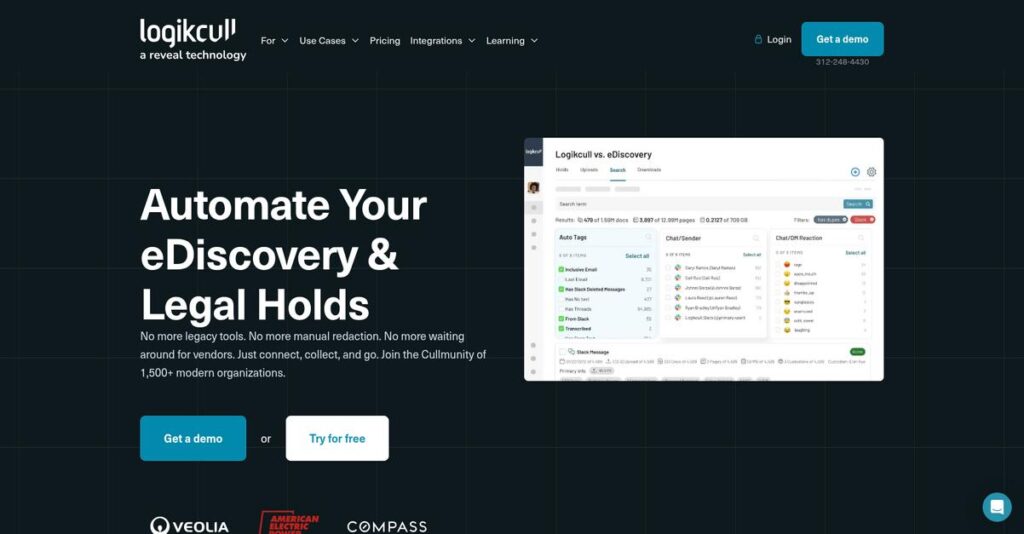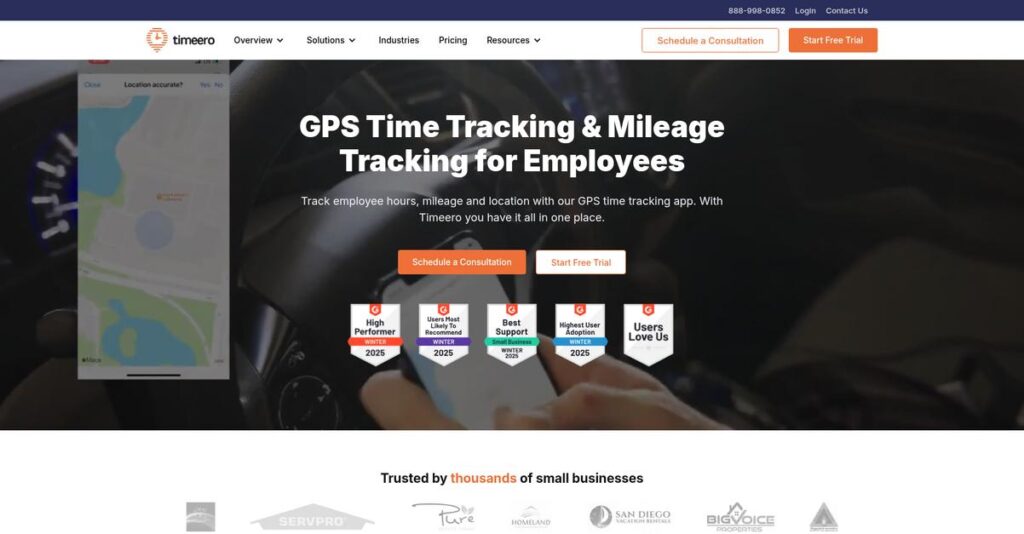Data silos slow down your business decisions.
If you’re struggling to get a complete, real-time view across cloud, on-premise, and SaaS data sources, you’re not alone. Connecting it all without endless data copying is no small feat.
My evaluation reveals: slow, fragmented data access holds your projects back and can frustrate your analytics and IT teams daily.
In my analysis of Denodo, I found their virtual data layer removes the need for traditional ETL, speeds up data delivery, and gives you trusted data access—without costly replication. The platform’s AI-driven optimization and centralized data catalog stand out from other options.
This review uncovers how Denodo can unify your data instantly, putting actionable insights within reach.
You’ll discover in this Denodo review how its features, deployment options, real-world pricing, and key alternatives measure up, especially if you need to modernize or simplify data access.
You’ll walk away knowing the features you need to confidently evaluate if Denodo is right for your company.
Let’s dive into the analysis.
Quick Summary
- Denodo is a data virtualization platform that unifies access to disparate data sources without physical replication.
- Best for mid-market to large enterprises needing a single virtual data layer across cloud and on-premise systems.
- You’ll appreciate its dynamic query optimizer and broad connector library that speed up complex data queries and integration.
- Denodo offers custom enterprise pricing plus a 30-day free trial via cloud marketplaces for initial evaluation.
Denodo Overview
Denodo has been around since 1999, headquartered in Palo Alto. From my research, their entire mission is giving you a single, unified view of all enterprise data without costly replication.
They specifically target enterprises struggling with complex, siloed data. You’ll notice they aren’t a generic, one-stop-shop. Instead, they focus purely on their logical data management approach, which is a key market differentiator for them.
The recent Denodo 8 platform update, integrating AI for smarter query optimization, was a significant move. This Denodo review found their expanded cloud partnerships also show clear innovation.
Unlike broad data suites or walled-off cloud-native tools, Denodo’s key advantage is providing a truly vendor-neutral layer. My analysis shows this specialized focus on virtualization often results in superior performance for your complex queries.
They work with major global organizations in demanding sectors like finance, healthcare, and manufacturing. You’ll find their solution inside companies that must unify data across many different systems.
What stood out during my evaluation is Denodo’s strategic focus on maturing the logical data fabric. Their heavy emphasis on AI-driven optimization and true multi-cloud flexibility directly addresses modern data integration challenges you’re likely facing.
Now let’s analyze their core platform capabilities.
Denodo Features
Data silos are a business bottleneck.
The Denodo Platform is an integrated solution that unifies disparate data sources in real-time, helping you make smarter decisions. These are the five core Denodo features that transform how you interact with your data.
Speaking of diverse information, my guide on Android data recovery software could assist in preserving critical data.
1. Logical Data Virtualization Engine
Still copying data around your organization?
Traditional ETL processes create painful delays and significant costs. This often prevents real-time insights your business desperately needs to react quickly.
Denodo’s engine connects to diverse sources without moving data, creating a virtual, unified layer. From my testing, this virtually unifies scattered data in real-time. This feature translates queries to native sources, fetching only the required information without replication.
You get current data, drastically cutting replication costs and speeding up the delivery of new data products and reports.
2. Dynamic Query Optimizer
Complex queries crippling your speed?
Querying across varied systems, like combining cloud data with on-premise, can be painfully slow if not done intelligently.
This is Denodo’s “secret sauce.” It analyzes queries and underlying sources, optimizing execution plans for maximum speed. What impressed me most is how it intelligently pushes processing down to powerful source systems. This feature ensures faster responses.
You gain interactive BI and analytics on data previously too slow to combine, empowering self-service for your entire team.
3. Integrated Data Catalog
Can’t find or trust your data?
Data analysts often waste hours searching for data they can actually trust. A lack of reliable context ultimately cripples adoption and productivity.
The Denodo Platform automatically indexes metadata, creating a searchable catalog. This is where Denodo shines, providing data lineage, business definitions, and AI recommendations. This feature helps you understand data context.
You get a “Google search for your data,” increasing productivity and building vital trust for data governance and use.
4. Centralized Security & Governance
Security policies a compliance nightmare?
Managing consistent security and compliance across dozens of unique data systems is complex and riddled with inconsistencies and potential gaps.
Denodo offers a single point for defining and enforcing security. From my evaluation, you can set up role-based, column, or row-level security effortlessly. This feature also dynamically masks sensitive PII data.
You dramatically simplify compliance audits and ensure consistent security, regardless of how data is accessed, protecting your sensitive information.
5. Multi-Cloud & Hybrid Deployment
Hybrid data environments slowing you down?
Bridging data from on-premise systems with multi-cloud strategies often complicates data access and management, creating operational headaches.
Denodo is cloud-agnostic, deploying on AWS, Azure, GCP, or on-premise. Here’s what I found: it seamlessly connects and queries data across these environments. This feature means your applications work uninterrupted.
You gain maximum flexibility, avoid cloud vendor lock-in, and smoothly support cloud migration by bridging data silos across locations.
Pros & Cons
- ✅ Exceptional performance across diverse and distributed data sources.
- ✅ Extensive library of connectors for virtually any data source.
- ✅ Significant reduction in data integration and reporting time.
- ⚠️ Requires specialized training due to a steep learning curve and VQL.
- ⚠️ Initial setup and ongoing administration can be highly complex.
What I love about these Denodo features is how they work together, creating a comprehensive logical data fabric for your entire organization. This unified approach helps you manage and access all your data efficiently.
Denodo Pricing
Denodo pricing avoids one-size-fits-all packages.
Denodo pricing is primarily based on a custom quote model, designed to precisely match your enterprise’s unique data virtualization requirements. This approach ensures your investment directly reflects the complexity and scale of your operations.
Cost Breakdown
- Base Platform: Custom quote: high five- to six-figure annual range
- User Licenses: Custom quote based on CPU cores and data sources
- Implementation: Varies: Often 25-50% of first-year license
- Integrations: Varies by complexity and connector type
- Key Factors: Data sources, CPU cores, specific features, professional services
1. Pricing Model & Cost Factors
Custom quotes for complex needs.
Denodo’s pricing model is custom-tailored, avoiding generic tiers by aligning costs directly with your data infrastructure’s specifics. What I found regarding their pricing is that your total cost depends on factors like CPU cores utilized, number of data sources, and specific features you truly require.
This means your budget gets optimized, allowing you to scale precisely with your actual usage rather than paying for unused capacity. Your investment is truly cost-effective.
2. Value Assessment & ROI
Maximize your data investment.
Denodo’s value proposition centers on real-time data access and simplifying complex data landscapes. From my cost analysis, this delivers significant ROI by reducing data replication and speeding up data delivery. Compared to traditional ETL or manual integration, their pricing supports impressive agility, transforming how your teams access critical information.
What you pay for translates into faster insights and improved decision-making, directly impacting your business’s operational efficiency and competitive edge for success.
While we’re discussing operational efficiency, understanding 11+ Best Regulatory Change Management Software is equally important for long-term success.
3. Budget Planning & Implementation
Plan for more than licenses.
When considering Denodo pricing, you must factor in total cost of ownership beyond just the license. Expect additional costs for professional services like implementation, training your team, and specialized support packages. From my cost analysis, this ensures a successful deployment but adds significantly to your initial budget, especially for complex integrations.
So for your business, budget accordingly for these upfront expenses. This practical guidance helps you avoid surprises and ensures a smooth launch.
My Take: Denodo pricing prioritizes enterprise-grade customization, ideal for large organizations that need a highly scalable data virtualization platform without paying for a rigid, one-size-fits-all solution.
Overall, Denodo pricing reflects a strategic investment in enterprise data fabric capabilities, ensuring your budget aligns with sophisticated data management needs. Contact their sales team to get a quote tailored for your specific environment.
Denodo Reviews
User feedback tells an interesting story.
My analysis of Denodo reviews reveals a clear pattern. I’ve compiled insights from platforms like Gartner, G2, and TrustRadius, offering you a balanced view of real user experiences with this powerful platform.
1. Overall User Satisfaction
Users seem highly satisfied.
From my review analysis, Denodo maintains a strong overall rating, typically around 4.4 out of 5 stars across major platforms. What I found in user feedback is how Denodo users generally express high satisfaction, especially considering the complex data integration problems it consistently solves. These reviews consistently highlight its robust performance and transformative impact on data accessibility.
This indicates you can expect a reliable, high-performance solution, significantly impacting your data strategy, if you commit to its proper implementation.
2. Common Praise Points
Users love its powerful connectivity.
What I found in user feedback is consistent praise for Denodo’s dynamic query optimizer and extensive connectivity options. From the reviews I analyzed, users consistently highlight reduced ETL and development time, citing Denodo’s ability to seamlessly integrate diverse data sources. It truly simplifies complex data landscapes, allowing your teams to deliver more quickly.
This means you’ll achieve faster, more reliable data access and quicker insights, making your data teams far more efficient.
Speaking of team efficiency, if you’re looking to elevate your customer calls, my guide on automatic call distribution software can help.
3. Frequent Complaints
Complexity is a common concern.
From my review analysis, the most frequently cited complaints revolve around Denodo’s steep learning curve and overall complexity. What stood out in customer feedback is how it’s not a plug-and-play solution, often requiring specialized skills in VQL and dedicated architectural resources. Users consistently mention high licensing costs too.
While significant, these challenges indicate Denodo is best suited for enterprises ready to invest in proper training and skilled personnel.
What Customers Say
- Positive: “Its ability to connect to a wide variety of sources with diverse formats and present them as a single unified view is the best feature.”
- Constructive: “It takes a dedicated team to manage, and training is needed for developers. The user interface, while powerful, can be clunky.”
- Bottom Line: “Reduced data set delivery from weeks to days, eliminating ETL jobs. It’s now the single source of truth for our BI team.”
Overall, Denodo reviews paint a picture of powerful capability balanced by a significant investment requirement. What I found is user satisfaction aligns with technical readiness.
Best Denodo Alternatives
Overwhelmed by too many similar software options?
Choosing among the best Denodo alternatives requires understanding your specific needs. I’ve analyzed the competitive landscape to help you determine which solution truly aligns with your unique business requirements.
1. Starburst (Trino)
Need extreme speed for data lake analytics?
Starburst excels at high-performance interactive analytics directly on massive data lake datasets, leveraging open-source Trino. From my competitive analysis, Starburst provides unparalleled query speed for SQL-based BI workloads, often more cost-effectively for this specific use case. This alternative shines for pure analytical intensity.
Choose Starburst when your priority is lightning-fast query execution on vast data lakes for BI and analytical applications.
2. Dremio
Building your strategy around a data lakehouse?
Dremio focuses on accelerating BI and SQL workloads directly on data lake storage, acting as a true ‘Data Lakehouse Platform.’ What I found comparing options is that Dremio optimizes performance with columnar caching and Apache Arrow, making it a strong alternative for modern cloud-native architectures where your data resides in lakes.
You’ll want to consider Dremio if your entire data strategy centers on the data lakehouse paradigm and BI acceleration.
3. Informatica (Intelligent Data Management Cloud)
Looking for an all-in-one data management platform?
Informatica offers a much broader Intelligent Data Management Cloud, encompassing ETL, data quality, and master data management, with data virtualization as just one component. Alternative-wise, Informatica delivers comprehensive data capabilities for organizations seeking a single-vendor solution for all their data needs, not just virtualization.
Choose Informatica when you require a unified, extensive suite for enterprise-wide data management, not just a specialized virtualization tool.
4. Cloud-Native Solutions (e.g., Azure Synapse Analytics, Google BigQuery Omni)
Primarily operating within a single cloud?
Tools like Azure Synapse Analytics or Google BigQuery Omni provide tight integration with their respective cloud ecosystems, offering powerful data integration capabilities. From my competitive analysis, cloud-native alternatives simplify single-cloud adoption and can appear more cost-effective as part of your existing cloud spend, though they lack multi-cloud flexibility.
Consider these solutions when your data landscape is almost entirely within one cloud provider and you prefer native integrations.
Speaking of safeguarding your digital assets, my article on anti spyware software can help protect your data and boost performance.
Quick Decision Guide
- Choose Denodo: Building a logical data fabric across diverse sources
- Choose Starburst: High-speed analytical queries on massive data lakes
- Choose Dremio: Accelerating BI performance on a data lakehouse architecture
- Choose Informatica: Comprehensive, single-vendor enterprise data management suite
- Choose Cloud-Native: Deep integration for data entirely within one cloud
The best Denodo alternatives require you to carefully assess your specific architecture, data volume, and strategic objectives. I recommend you focus on your unique technical and business priorities to make the optimal choice.
Setup & Implementation
Considering Denodo? Here’s what implementation entails.
A Denodo review reveals this isn’t a plug-and-play solution. Its powerful capabilities require a strategic deployment approach, so set realistic expectations for your implementation journey.
1. Setup Complexity & Timeline
It’s no simple software installation.
Denodo implementation is a significant IT project demanding careful planning and data architecture expertise. You’ll configure source connections, security, and virtual data models. What I found about deployment is that full operational status takes weeks to months, depending on your existing data complexity and team’s readiness.
Plan for dedicated project management and data architecture expertise upfront. Proper upfront scoping prevents costly delays.
2. Technical Requirements & Integration
Expect substantial technical involvement.
Your team needs robust server resources (on-prem or cloud VMs) with sufficient CPU, RAM, and network bandwidth. A deep understanding of data modeling and SQL is crucial. From my implementation analysis, technical expertise is non-negotiable for configuring complex integrations.
Ensure your IT team has the necessary skills in data modeling and SQL. Budget for potential infrastructure upgrades and integration specialists.
If you’re also exploring various software tools, my guide on AI Image Generators Software offers insights into visual quality solutions.
3. Training & Change Management
User adoption requires strategic planning.
Your team will learn Denodo’s Virtual Query Language (VQL) and its administration console. There’s a definite learning curve, requiring specialized training. Implementation-wise, successful adoption hinges on dedicated data engineers who become platform specialists, guiding others through new paradigms.
Invest in Denodo’s comprehensive training resources. Appoint internal champions and plan for ongoing support to overcome the learning curve.
4. Support & Success Factors
Support is critical for success.
Denodo’s enterprise support is consistently praised for responsiveness and knowledge. This quality assistance is vital for resolving complex integration and performance-tuning issues. What I found about deployment is that responsive vendor support is a key differentiator.
Leverage Denodo’s support proactively for complex scenarios. Establish clear communication channels and engage support early in your planning phases.
Implementation Checklist
- Timeline: Several weeks to 6 months depending on scope
- Team Size: Dedicated project manager, data architects, and IT specialists
- Budget: Beyond licensing: professional services, server resources, training
- Technical: Data modeling, VQL, and robust server infrastructure
- Success Factor: Strong internal expertise and proactive vendor support
Overall, Denodo implementation is a significant undertaking requiring upfront commitment and skilled resources. However, the long-term benefits outweigh initial complexities, making it a valuable investment for data-rich enterprises.
Who’s Denodo For
Denodo serves a very specific business need.
This Denodo review section helps you assess if its powerful data virtualization capabilities align with your enterprise. We’ll analyze ideal business contexts, team sizes, and use cases where Denodo excels or falls short.
1. Ideal User Profile
For complex data environments.
Denodo is ideal for large enterprises and mid-market organizations grappling with highly fragmented data landscapes. From my user analysis, your team will consist of data architects and engineers. These users find it invaluable for creating a unified data access layer, enabling self-service analytics without extensive ETL.
You’ll see strong success if centralized data governance across diverse sources is a critical, ongoing requirement for your enterprise.
2. Business Size & Scale
Mid-market to large enterprises.
Denodo’s robust platform is designed for mid-market to large enterprises grappling with significant data volume and complexity. What I found about target users is that your team needs dedicated data engineers or architects. It is generally overkill for small businesses seeking simple data connectors, given its inherent operational overhead.
You’ll know it’s a good fit if your data infrastructure involves 10+ disparate systems and substantial IT resources.
3. Use Case Scenarios
Unifying fragmented data sources.
Denodo truly excels when your primary goal is a single, logical access point for data scattered across numerous systems. From my analysis, this software significantly reduces ETL complexities for self-service BI and analytics initiatives. It’s also strong during cloud migrations, providing a stable data layer.
You’ll appreciate this if your business frequently needs to integrate new data sources rapidly and consistently without physical replication.
4. Who Should Look Elsewhere
Not for beginners or small budgets.
If you’re a small business or prefer “plug-and-play” solutions, Denodo is likely not for you. From my user analysis, its steep learning curve and high cost make it unsuitable for those without dedicated technical teams. It requires specialized training to master.
Consider simpler, more intuitive data integration tools or cloud-native data warehousing solutions if your budget is limited.
Best Fit Assessment
- Perfect For: Mid-to-large enterprises with highly fragmented data landscapes
- Business Size: Mid-market to large enterprises with complex data needs
- Primary Use Case: Unifying disparate data sources for real-time BI/analytics
- Budget Range: Enterprise-level investment for advanced data virtualization
- Skip If: Small business or seeking simple, low-cost data integration
The answer to who should use Denodo review comes down to your enterprise’s complex data needs and technical resource availability. You’ll truly benefit if your challenge involves unifying vast, fragmented data. Denodo suits complex enterprise data environments.
Bottom Line
Denodo delivers powerful data virtualization.
My Denodo review offers a clear verdict on its capabilities, helping you determine if this advanced data integration platform aligns with your enterprise needs and strategic objectives.
1. Overall Strengths
Unlocking data potential effectively.
The Denodo Platform excels by providing unparalleled connectivity to diverse data sources and a dynamic query optimizer for real-time performance. From my comprehensive analysis, its ability to unify disparate data without replication is a standout capability, drastically reducing ETL efforts and development time.
These strengths translate directly into faster data access, improved agility, and a single source of truth for critical business intelligence.
2. Key Limitations
Navigating notable implementation hurdles.
However, the platform presents a significant learning curve, requiring specialized skills in VQL and extensive configuration for optimal use. Based on this review, the high licensing cost primarily targets large enterprises, making it less accessible for mid-market or smaller organizations.
These challenges necessitate a substantial investment in training and dedicated resources, which could be a deal-breaker for some businesses.
3. Final Recommendation
A strategic investment for complex data.
You should choose Denodo if your organization faces highly complex, siloed data landscapes and has the technical resources to leverage its advanced features. From my analysis, it excels for large-scale data unification efforts where real-time access and performance across heterogeneous systems are paramount.
My recommendation is strong for well-resourced enterprises seeking robust data virtualization, but proceed with caution if resources are limited.
Bottom Line
- Verdict: Recommended with reservations
- Best For: Large enterprises with complex, siloed data and dedicated IT teams
- Biggest Strength: Unparalleled connectivity and dynamic query optimization
- Main Concern: Steep learning curve and high implementation complexity
- Next Step: Request a detailed demo for your specific data environment
This Denodo review offers a comprehensive look, and I am confident it provides clear guidance for your software decision. Consider your resources.






